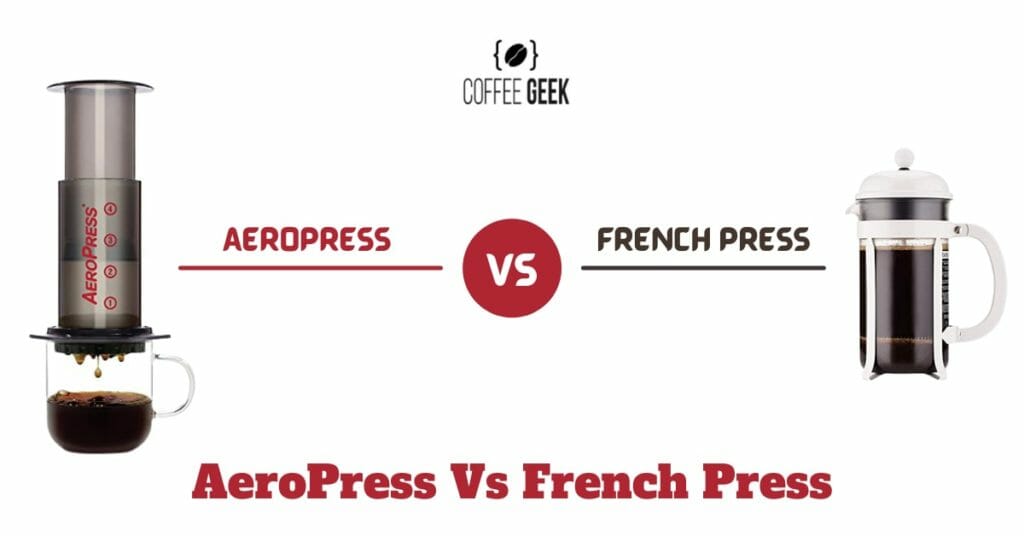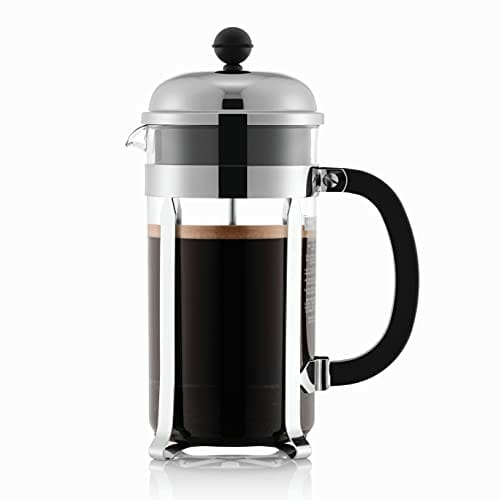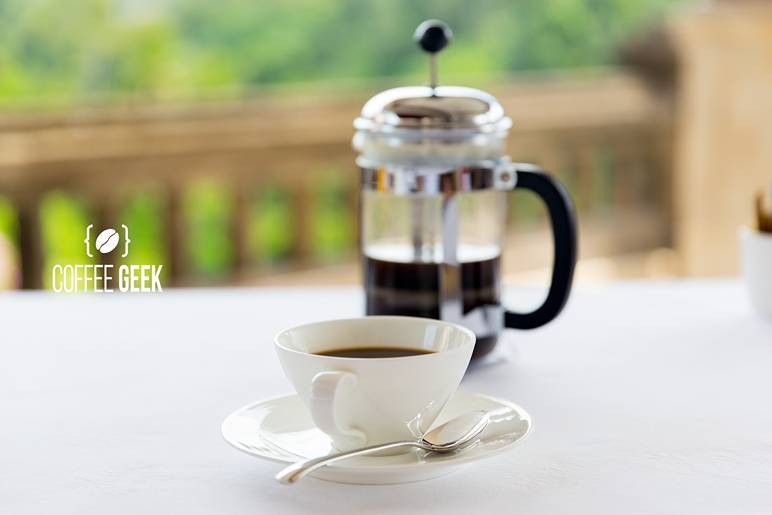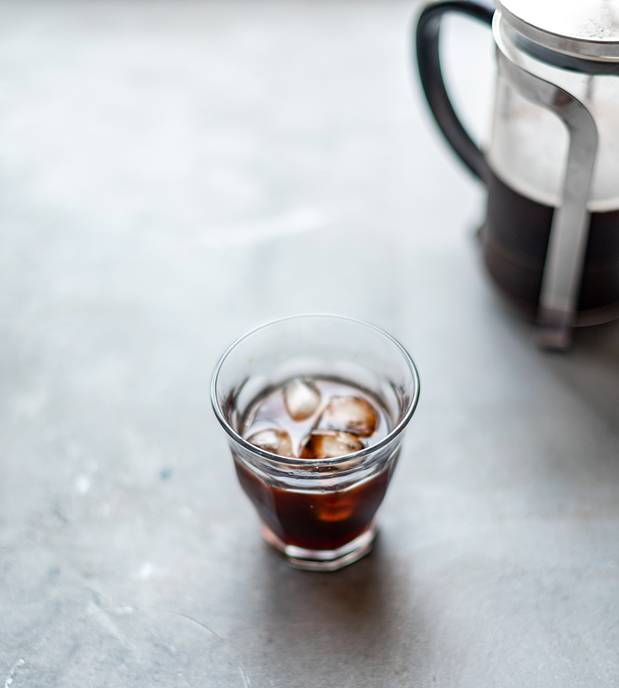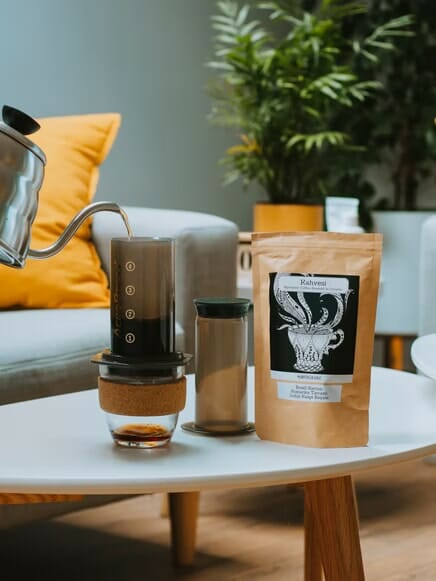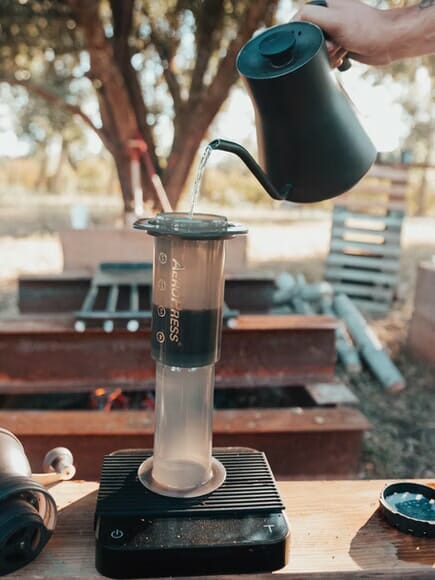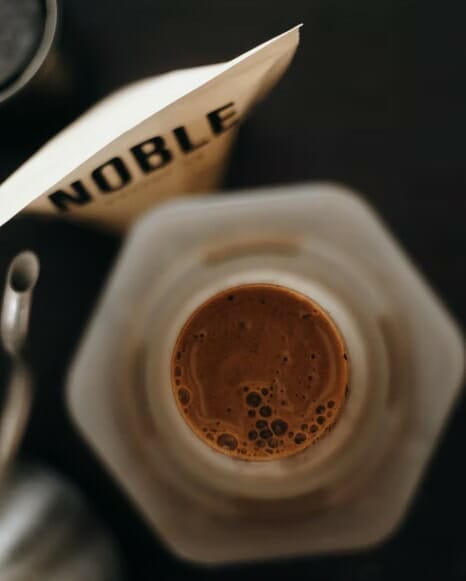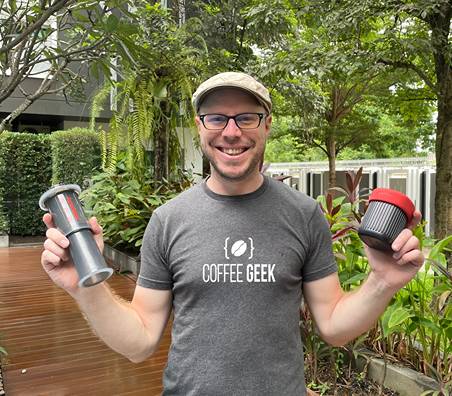AeroPress and French Press are definitely among the top choices for coffee drinkers looking for popular coffee makers that are straightforward to use and make delightful full-bodied coffee.
In this article, you’ll be able to read the comprehensive battle of AeroPress vs French Press. How are the AeroPress and French Press different from each other? Which one is better for your lifestyle and coffee preferences? Let’s find out.
What Is A French Press?
A French Press is a manual coffee-making device that’s also known as a cafetiére, a coffee plunger, or a press pot.
At first glance, it looks like a thin and small carafe.
Other than the obvious beaker and the lid, the device is also equipped with a plunger and a metal mesh filter attached at the end of the plunger rod.
How Does The French Press Work?
But its appearance isn’t the only thing that’s straightforward.
French Presses brew coffee by the immersion brew method, which essentially means steeping the coffee grounds in hot water to extract coffee compounds.
All the coffee lovers have to do is add coffee grounds and hot water to the beaker, let it steep for a couple of minutes, then press down the plunger.
The French Press filter on the plunger rod will effectively keep the used coffee grounds at the bottom, leaving flavorful coffee on top.
How To Make French Press Coffee

Ingredients
How should the coffee bean and the water be when brewing coffee with French Press brewers?
Coffee Grounds
Medium to dark-roasted coffee beans is the go-to choice of many coffee aficionados when making coffee using this device.
This range of roast profiles gives the coffee tastes more strength and body for the signature French Press cup.
In addition, the coarse grind is the best pick as the coffee grounds can’t slip through the metal mesh filter as easily as the finer grind sizes.
It’s also much easier to time the extraction with a coarse grind as it doesn’t become bitter and over-extracted as fast as fine grounds.
Water
The appropriate water temperature for brewing coffee is 195 – 205 degrees F (91 – 96 degrees C).
Make sure you get the coffee-to-water ratio that best suits your personal taste. For starters, go with a 1:15. Increase or reduce the amount of water depending on how weaker or stronger you want the coffee to be.
Instructions
Here are some simple instructions to give you an idea of what brewing coffee using a French Press is like.
- Step 1: Preheat the device.
- Step 2: Add coffee grounds to the device.
- Step 3: Wet the grounds with hot water and let them bloom.
- Step 4: Add more hot water and let it steep.
- Step 5: Press down the plunger.
- Step 6: Decant the coffee.
Pros Of The French Press
Ease Of Use
If you’ve read the previous sections, you would know by now that using this is virtually effortless and very user-friendly.
Unlike the complicated Pour-Overs that require you to master the water pouring skill, what you need to pay attention to isn’t the way you plunge, but rather the ingredients, as I’ve previously mentioned, and the steeping time (brew time).

An advantage of this brew method is that you don’t have to stay close to the coffee maker all the time. Just set up an alarm, go finish off your morning routine, and return once the coffee has finished steeping.
So just make sure to time it right so that the coffee doesn’t come out under-extracted, watery, and poor or over-extracted and bitter.
Taste
If you’re into the dark, rich, and mouthful cup of Joe with robust flavors, French Press coffee is for you.
You can drink it as it is or ease the sharpness and depth with sugar and cream.
Versatility
French Press makes a very good argument in this round of versatility. With a French Press at home, other than a simple cup of straight black, you can make an array of other coffee drinks as well.
Espresso-Based Beverages
Thanks to the full body and dark flavor profiles, French Press makes a good alternative candidate to the classic espresso.
By adding more water, you can make a mock Americano.
Steam milk with a frother to make beautiful latte art and milk espresso-based drinks such as latte, cappuccino, and flat white with a French Press coffee base.
Iced Coffee
Pour the drink over ice cubes and you’ve got yourself a refreshing cup of iced coffee.
Cold Brew
If iced coffee is too diluted and lackluster for you, give Cold Brew coffee a try.
This strong and heavy Cold Brew can also be made using immersion brewing methods with the help of the French Press.
All you have to do is letting the coffee grounds sit in cold water, rather than hot, in the glass carafe of the French Press for an extensive brew time, around 12 – 24 hours.
This brewing process will thoroughly extract all of the good coffee compounds into the water. Then filter the sludge afterward to acquire the coffee concentrate.
Tea
Since the French Press utilizes immersion brewing methods, users can also use this brewing device to make tea, another drink that involves steeping ingredients in hot water.
Tea and coffee enthusiasts can definitely benefit from buying a versatile French Press.
Quantity
A French Press can typically handle multiple cups of Joe. The coffee makers also come in various sizes to meet the needs of all coffee enthusiasts.
The Bodum Chambord French Press, popular for its classy glass carafe and chic metal frames, is available in 4 sizes:
- 12 oz (355 ml) = 3 servings
- 17 oz (503 ml) = 4 servings
- 34 oz (1 l) = 8 servings (most popular choice)
- 51 oz (1.5 l) = 12 servings
Portability
The French Press I introduced above is relatively compact.
However, the glass brewing chamber can be an issue during traveling.
Luckily, other than glass models, you can also find French Press in more durable materials to bring fresh coffee with you on the go.
One of the most popular portable stainless steel French Presses is the ESPRO P0 Ultralight Double Walled Stainless Steel Vacuum Insulated Coffee French Press.
Marketed as the World’s lightest travel press, the ESPRO P0 French Press can be your companion on all future adventures with its durable stainless steel material, lightweight, and neat filter effectively ceasing extraction.
Cost
Both the glass French Press and stainless steel version costs up to around $50, an affordable price for delicious coffee.
Cons Of The French Press
Brew Time
If we take the amount of time it takes to prepare ground coffee and near-boiling hot water out of the equation, making French Press coffee takes at least 4 minutes following our coffee brewing method.
Making French Press coffee is pretty fast, but not lightning fast.
Luckily, to make French Press coffee, you only need to prepare coarse ground coffee. That’s less time on the grinder than it would take for finer grind size.
Extraction
“Why French Press coffee is bad for you?” This is a common French Press debate that you might see pop up often on the People also ask section when searching on Google about this brewing device.
So, is it true? If so, how come?
The French Press works without a paper filter and only makes coffee with its available mesh metal filter. So, there’s a risk of unwanted coffee grounds, oils, and bitter notes slipping through the relatively large holes of the stainless steel mesh filter.
This results in a less than ideal not-so-clean cup of Joe, which might not be considered a good cup for many coffee drinkers.
But it doesn’t stop there. The filter on the French Press doesn’t work as well as the paper filter to trap coffee oils that can, in fact, be harmful in large amounts. One notable effect is raising your cholesterol levels.
However, to suffer from significant impacts, one needs to consume at least 5 cups of French Press a day and has already struggled with related health issues.
So, the bottom line is, the lack of a paper filter in coffee extraction can make a cup of French Press less clean and potentially more harmful with excessive consumption compared to other brew methods.
But as long as the dark flavor and mouth feel meet your taste preferences, the average Joe can freely drink up to 4 cups a day with no worries.
Cleaning
A bit more effort can be involved in cleaning French Presses compared to brewing techniques utilizing a paper filter. You can’t just toss the filter in the trash, run a simple rinse and call it a day.
But, the cleaning process for this device isn’t that complicated, either. To get rid of the sludge, add water to the French Press and pour the content into a mesh strainer. Then clean the carafe and the plunger thoroughly with soap, water, and a non-abrasive sponge.
Once in a while, give the coffee maker a descaling bath to remove mineral and oil build-ups and make a perfect cup of Joe always.
What Is An AeroPress?
AeroPress is another manually operated coffee-making device popular for its portability and syringe-like appearance.
It has a long tubular brewing chamber, to the end of which a filter cap is attached. AeroPress also has a thick plunger with an airtight silicone seal that’s supposed to enter the other side of the brewing chamber.
So it looks and works essentially similar to a syringe, without the needle, of course.
The AeroPress also comes with a paper filter holder, a year supply of paper filters, a stirrer, a ground scoop, and a funnel. All the help you need to make a cup of AeroPress coffee.
How Does The AeroPress Work?
Is AeroPress similar to the French Press? The answer is a little bit.
The traditional way of making AeroPress coffee involves quickly immersing coffee grounds in hot water then pressing down the plunger to push the extracted coffee through the filter cap into the serving cup below.
So, aside from the word “press” in their names, they do have the plunger and plunging action in common.
But the AeroPress also has a silicone seal attached to the plunger.
This applies air pressure during the plunging process to extract more espresso-like coffee bodies and flavors.
Aside from the Traditional method, users can also invert the whole AeroPress piece to make coffee.
With the plunger on the counter inserted into the chamber, the coffee steeps in hot water inside the inverted chamber.
Afterward, the filter cap is twisted onto the chamber and the user flips the whole piece to plunge the extracted coffee into the serving cup.
It’s a bit eccentric but creative and makes good coffee nonetheless.
How To Make AeroPress Coffee

Ingredients
Coffee Grounds
The French Press’s immersion method utilizing coarsely ground coffee so that they wouldn’t slip through the metal filter. This, naturally, calls for a longer brew time to extract coffee.
The AeroPress, on the other hand, requires finely ground coffee, and a much shorter immersion time.
Water
Like most coffee-making methods, the water temperature for making AeroPress coffee is also around 195 – 205 degrees F (91 – 96 degrees C).
There is less math involved when it comes to the coffee-to-water ratio for making a cup of AeroPress thanks to the accompanying ground scoop and water level mark on the chamber.
Just follow the recipe below to make yourself a cup of Joe. Add more or less water next time if you find the result too strong or weak.
Instructions
Below are 2 methods for making coffee using an AeroPress.
Traditional Method
- Step 1: Place a paper filter into the cap and twist it onto the chamber. Place the assembled on a sturdy cup.
- Step 2: Add one scoop of ground coffee to the chamber and shake it to level the ground bed.
- Step 3: Add hot water to Level 1.
- Step 4: Stir the mixture with the stirrer for 10 seconds.
- Step 5: Insert the plunger and slowly press it down.
Inverted Method
- Step 1: Insert the plunger into the chamber and place the assembled upside down.
- Step 2: Follow the Traditional method’s steps 2 – 4.
- Step 3: Soak the filter with hot water and place it into the cap. Twist the cap onto the chamber.
- Step 4: Invert the whole piece and place it on a sturdy cup.
- Step 5: Slowly press the plunger down.
Pros Of The AeroPress
Brew Time
In this battle of AeroPress vs French Press, AeroPress takes the lead in the brew time race.
Thanks to the finer grind size and the air pressure applied, the brew time is effectively shortened to as fast as 2 minutes.
That’s disregarding the time it takes to prepare coffee and water, of course. But, even that can be faster as well.
You might need a scale to get the amount of coffee and water right as a beginner user of the French Press. But, for the AeroPress, with the help of the scoop, funnel, and water level mark on the chamber, there’s no need for weighing and separate containers to get the ratio right.
But you do need to stay next to the brewer and participate the whole time, whereas a cup of French Press lets you take a breather while it’s steeping.
Ease Of Use
Like the French Press, the brew method is simple and easy to navigate. No complicated pouring skills. As long as you get the ratio right, you’ve pretty much mastered the craft.
But you do need to pay a bit of attention to the plunger on this device. Due to the silicone seal, it won’t go down smoothly. Just take it slow and pause for a bit if there’s resistance.
Taste & Extraction
As I’ve previously stated, due to the air pressure, the brand AeroPress refers to its coffee as espresso-style.
But the short brew time and paper filter incorporated helps make the brew strong and clean and less bitter and oily compared to a cup of French Press.
Versatility
Like the French Press, you can use coffee made with an AeroPress as an espresso substitute and make espresso-based drinks and add ice to make iced coffee.
You can also make Cold Brew with the Traditional method by replacing hot water with cold water and stir for 1 minute instead of just 10 seconds.
And, although the AeroPress can’t brew tea like French Press, you can flex the Inverted method as an alternative brewing method.
Portability
As you can see, I first introduced this device with its amazing portability.
Thanks to the compact size and sturdy BPA-free plastic material, AeroPress is born to make delicious coffee on the go.
There’s also another version called AeroPress Go which is made specifically for that purpose.
It comes with a coffee mug that also acts as the device’s container.
Cleaning
Just as easy as making coffee with the AeroPress, cleaning up is a piece of cake as well.
Discard the coffee filter after your solid cup of Joe, run the components through water after each brew and you can call it a day. The whole process is definitely simpler and takes less time than the French Press’s.
And like you would with all devices, remember to give it a descaling bath once in a while as well.
Cost
The AeroPress is an even more affordable option than the French Press. Both versions are around $30 only for easy coffee everywhere.
Cons Of The AeroPress
Quantity
The only significant con of AeroPress is its brewing capacity. It’s better known as a single-cup brewer as each extraction can only produce 10 oz (296 ml) of coffee for the OG model and 8 oz (237 ml) of coffee for the AeroPress Go model.
That makes at most 3 servings, which is only equal to the quantity the smallest version of French Press can make.
AeroPress Vs French Press: The Verdict
So, is Aeropress better than French Press? According to the number of pros and cons we’ve listed above, the general answer is yes. But, your final answer should depend on your lifestyle and taste preferences as well.
If you’re a fan of the full-bodied and strong taste of French Press, prefer its aesthetically pleasing classic look, don’t mind a bit extra time for brewing and cleaning, feel free to go for it.
Otherwise, pick the AeroPress for its clean taste, portability, ease of use and clean, and very affordable price tag.

